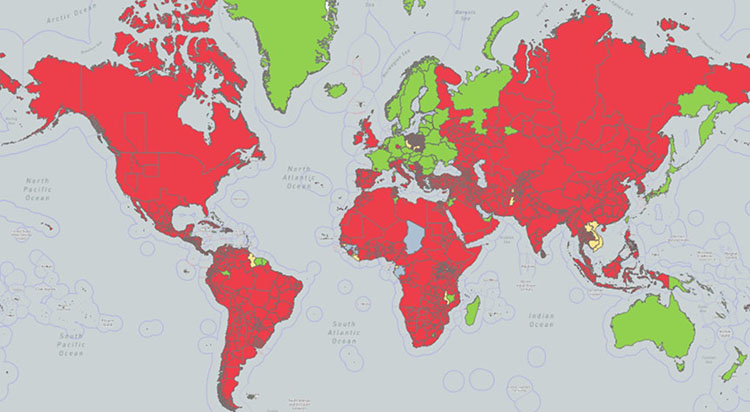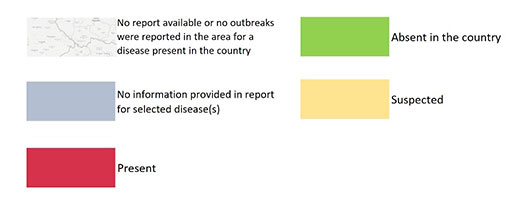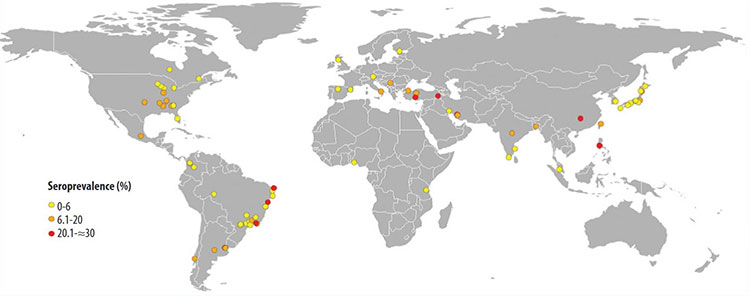The fight against Brucellosis in a One Health framework
The "Brucellosis 2022 International Research Conference", was organized by the Istituto Zooprofilattico Sperimentale dell’Abruzzo e del Molise - Teramo, on behalf of the International Brucellosis Society, and was held in Giulianova, Teramo, Italy from 16 to 19 September 2022. The event brought together international experts in the field of brucellosis, representing a key opportunity for sharing knowledge, experiences, and future perspectives on this disease.
Although more than 170 years passed since the first description of the disease in Malta, brucellosis is still a sanitary problem in many countries, both for human and animal health, with significant impact on livestock production in various areas of the World.
According to data from the World Organisation for Animal Health (WOAH), out of 182 member countries, Brucella abortus is currently still recorded in 87 countries, B. melitensis in 67 and B. suis in 28 (Figure 1).

Brucella abortus
Brucella melitensis
Brucella suis

Figure 1. Countries having reported Brucellosis to WOAH at least once in the period 2005-2019 (WOAH-WAHIS)
In particular, in some areas of Africa, Asia, Middle East, and Mediterranean countries, brucellosis still remains endemic with high infection rates. The assessment of the global situation, the emergence of new strains, and the strategies for containment and eradication of the disease were the main topics of the four-day congress, during which, more than 280 experts, scientists, and researchers discussed and shared knowledge and studies on the factors influencing the onset and spread of Brucella species in various animal populations and humans. The One Health approach characterized the discussion, with a dynamic and complementary collaboration among all parties involved: from animal health to human health, from breeders to the food industry, to regulatory bodies.
Brucella genus also represents a current issue in the field of advanced research. In the last 20 years, new environmental strains have been discovered. The three Brucella species most frequently isolated, which also represent the most common causes of human brucellosis, having spread worldwide over the centuries through animal movements, are Brucella melitensis, B. abortus, and some biovars of B. suis. However, the Brucella genus is much wider and, over the last 25 years, has quickly gone from 6 to 12 recognized species, with several other variants still not officially assigned. The new variants have been isolated in humans, other mammals, and more recently, fish, amphibians and reptiles. Strains present for a long time in the environment, but only now identified thanks to more advanced microbiological techniques and bacterial genome sequencing, are under the attention of researchers, also with the aim of assessing their potential danger to humans. The whole genome sequence showed that the genus can be divided into two distinct groups: 'classic' Brucella, which includes the main zoonotic strains, and 'atypical' Brucella, which contains many of the new isolates. The atypical strains are phenotypically distinguished from the classic ones as they show rapid growth, motility, a chemically and antigenically distinct O-antigen, and unique metabolic capabilities.
One significant topic highlighted during the conference was the emerging of new challenges, partly deriving from the global warming phenomenon, which seems to have an effect on the distribution of receptive hosts, but also due to the "intensification" of animal farming, with a progressive increase in the number of large herds and farms, hampering the proper application of control measures.
Another issue discussed during the conference was the presence of the disease in wild animal populations and the interactions between wildlife and farmed animals, which further complicate the correct application of necessary control measures.
The issue of animal vaccines represents perhaps an even more complex challenge, from both a scientific and a socioeconomic point of view. While research is advancing towards the creation of new vaccines, this effort may be insufficient if vaccination programs fail to reach and involve all stakeholders, from breeders to veterinary institutions.
The many aspects related to human infection were also discussed, considering that although it has been successfully eradicated in animals in some countries (Figure 1), human brucellosis is increasingly present throughout Southeast and East Asia, while it has re-emerged in North and East Africa.
Furthermore, both in Western Europe and in North America (but recently also in Europe), the growing spread of canine infections caused by Brucella canis constitutes a danger still to be defined in terms of human health impact (Figure 2). From the Giulianova conference, therefore, there has been a strong demand to formally consider human brucellosis as a still neglected disease.

Figure 2.Location and outcome of serological investigations for the detection of antibodies against B. canis recorded in the international scientific literature. Each point represents a published study; the colour of the point represents the identified source (Hensel et al., 2018)
An overview of the results of the conference, the reports and the posters presented (De Massis et al., 2022), gives the image of a global effort in the fight against Brucellosis that will increasingly have to be based on the concept of One Health. The consciousness about the proper disease control and eradication methods, the engagement and involvement of stakeholders, and the trust of breeders, are all unresolved issues in many areas of the planet, where the disease is endemic, and where infrastructure weaknesses, often exacerbated by geography, climate or conflict situations, require strongly dedicated approaches. Therefore, it is necessary to build practical capabilities by creating reference laboratories in critical areas and progressively implementing measures suited to each specific region, in order to avoid a direct and uncritical transfer of solutions from the so-called advanced countries.
References
- De Massis F, O’Callaghan D, Arenas A, Elzer P, and Hagius S (Eds). Proceedings of the Brucellosis 2022 International Research Conference. Edizioni IZSTe-press - Digital Publishing
- Hensel, M. E., Negron M., & Arenas-Gamboa A. M. (2018). Brucellosis in Dogs and Public Health Risk. Emerging Infectious Diseases, 24(8), 1401-1406
- WOAH WAHIS.
De Massis F.*, Pediconi O., Tittarellli M., D'Alterio N.
Istituto Zooprofilattico Sperimentale dell’Abruzzo e del Molise “G. Caporale”
*Corresponding author: f.demassis@izs.it